В случае, если вам потребовался доступ из Windows к данным на разделе диска с файловой системой Linux — ext4/ext3/ext2, встроенными средствами системы сделать это не получится. Однако, возможности есть, причем реализовать это можно встроенными средствами системы или с помощью сторонних инструментов.
В этой инструкции подробно о способах подключить раздел диска в файловой системе Linux в Windows 11 и Windows 10 для доступа к данным на этом разделе как для чтения, так и для записи.
Ext2 File System Driver (Ext2Fsd) — самый простой способ открыть раздел ext4/ext3/ext2 в Windows
Ext2 File System Driver или Ext2Fsd — сторонний и полностью бесплатный драйвер для подключения разделов Linux во всех версиях Windows начиная с XP. Несмотря на название, поддерживаются не только разделы не только с файловой системой ext2, но и более новые ext4 и ext3.
Порядок использования Ext2 File System Driver для доступа к дискам Linux будет следующим:
- Загрузите установщик Ext2Fsd с сайта https://sourceforge.net/projects/ext2fsd/
- Установите драйвер, в параметрах установки как правило не требуется ничего изменять.
- По завершении установки вам будет предложено запустить Ext2 Volume Manager (менеджер томов), запустите его.
- Нажмите правой кнопкой мыши по разделу Linux ext4, ext3, ext2 и выберите пункт «Assign Drive Letter» — назначить букву диска.
- Для раздела будет автоматически назначена буква диска, и вы увидите раздел в Проводнике Windows с возможностью чтения и записи файлов на нём.
В дальнейшем вы тем же способом сможете удалить букву диска с раздела (опция «Change letter» — «Remove»).
Доступ к разделам Linux средствами Подсистемы Windows для Linux (WSL)
Подсистема Windows для Linux (WSL) также может быть использована для подключения дисков Linux в Windows таким образом, чтобы доступ к ним был возможен из проводника. Шаги будут следующими:
- Запустите командную строку, Терминал или PowerShell от имени администратора и по порядку введите команды
wsl --install wsl --set-default-version 2 dism.exe /online /enable-feature /featurename:VirtualMachinePlatform /all /norestart wsl --install -d Ubuntu
- После выполнения последней команды откроется окно консоли Linux (командную строку при этом не закрывайте, она еще пригодится) с предложением настроить имя пользователя и пароль, сделайте это. Если в окне консоли вы увидите сообщение об ошибке, скачайте и установите обновление WSL, перезагрузите компьютер и запустите Ubuntu из меню «Пуск».
- В консоли Ubuntu введите команду
sudo mkdir -p /mnt/ext-drives/
для создания папки, к которой будут монтироваться диски.
- В консоли Windows (командная строка, терминал, Powershell) введите команду
wmic diskdrive list brief
- Обратите внимание на DeviceID диска, который нужно подключить и введите команду (так же в консоли Windows) указав соответствующий номер в имени PHYSICALDRIVE
wsl --mount \\.\PHYSICALDRIVE
- В консоли Ubuntu введите команду lsblk — это отобразит список подключенных дисков, разделов на них и их размер. В следующей команде используем имя нужного раздела для монтирования:
sudo mount /dev/sdИМЯ /mnt/ext-drives/
- После успешного выполнения всех указанных шагов вы можете зайти в Проводник Windows, выбрать пункт «Linux» в панели быстрого доступа, перейти в папку mnt\ext-drives и получить доступ к файлам на подключенном разделе Linux с возможностью записи и чтения.
В дальнейшем для отключения диска от WSL можно использовать ту же команду, которая использовалась на 5-м шаге, заменив mount на unmount.
Есть и другие программы (драйверы) для доступа к разделам Linux из Windows, но не полностью бесплатные. Среди них:
- DiskInternals Linux Reader — в бесплатной версии доступно только чтение данных с разделов.
- Paragon Linux File Systems for Windows — бесплатная работа в течение пробной версии, затем необходимо приобретать лицензию.
Содержание статьи:
- Как «прочитать» информацию на разделах с файловыми системами Ext2, Ext3, Ext4
- Способ 1 (через спец. драйвер)
- Способ 2 (через дополнения к TC)
- Способ 3 (с помощью LiveCD)
- Вопросы и ответы: 4
Доброго дня!
К сожалению «обычная» версия Windows не позволяет работать с дисками, отформатированными в файловые системы (ФС) Ext2, Ext3, Ext4 (используются в Linux). Всё, что доступно — это узнать о их существовании в управлении дисками, а вот скопировать файл — уже проблема…
Что делать?
Наиболее сподручный и самый удобный вариант (на мой взгляд) — установить в Windows спец. драйвер, который позволит ОС работать с дисками Ext2/3/4 также, как если бы они были отформатированы в NTFS (скажем). Т.е. любая программа в Windows (тот же проводник) сможет в обычном режиме работать с диском. Удобно?
Теперь о том, «что» выбрать…
*
Как «прочитать» информацию на разделах с файловыми системами Ext2, Ext3, Ext4
Способ 1 (через спец. драйвер)
Подобные «драйверы» есть от нескольких производителей. Я бы выделил продукт от Paragon (ссылка на офиц. сайт с драйвером). Почему:
- поддержка ФС: Ext2, Ext3, Ext4 (чтение + запись); Btrfs, XFS (только чтение);
- после установки драйвера — ничего «делать» не нужно: просто Windows начинает видеть накопители с Ext4+;
- совместим с ОС Windows 7/8/10 (плюс есть пробный период, которого хватает для возникшей задачи (обычно)).

Драйвер от Paragon
Обратите внимание, что «ненужные» разделы диска можно откл. и не монтировать. Настройка драйвера позволяет это сделать.
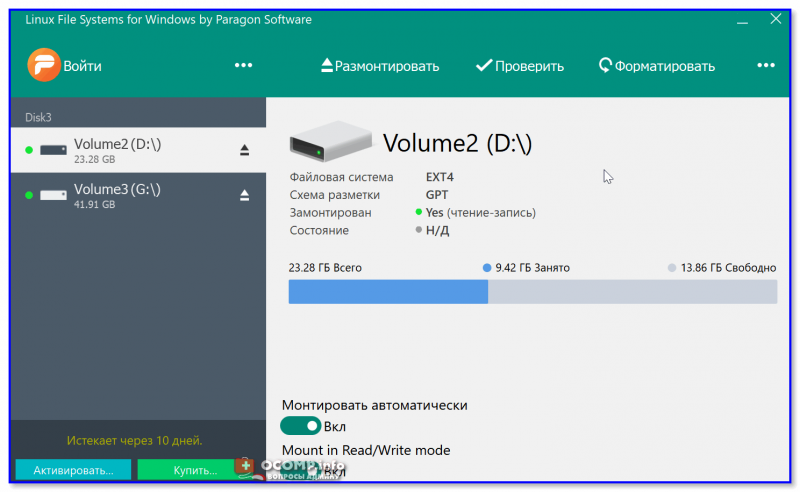
Главное окно (Linux File Systems for Windows by Paragon Software)
На скрине ниже привел окно проводника: как видите, раздел отображает как «обычный» — на него также можно что-нибудь скопировать / удалить.
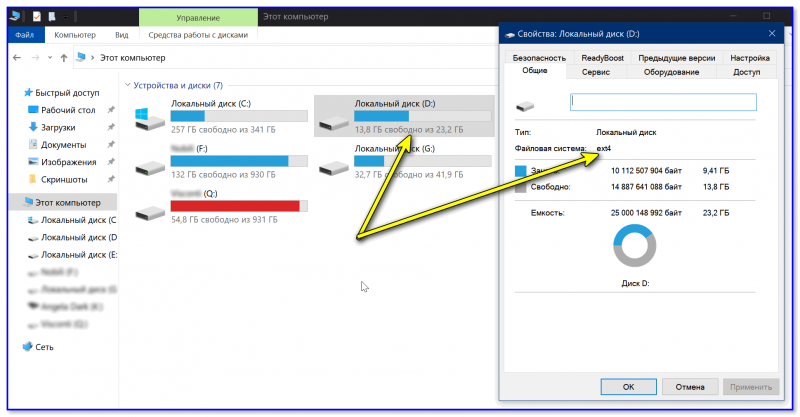
Этот компьютер — диски с ФС EXT4 появились в проводнике
👉 Дополнение!
На Sourceforge можно также найти бесплатный драйвер файловой системы Ext2/3/4 для Windows 7/8/10* (ориг. название: Ext2Fsd).
Сразу отмечу, что на некоторых ОС Windows 10 — драйвер этот ведет себя нестабильно, и не позволяет прочитать информацию с нужного раздела…
Продукт от Paragon, конечно, выигрывает…
*
Способ 2 (через дополнения к TC)
TC — это сокращенное название файлового коммандера Total Commander (некая замена проводнику). К этой программе есть очень много плагинов, и, разумеется, для чтения Ext2/3/4 ФС тоже есть!
Покажу по шагам, как в нем открыть подобный раздел диска…
1) Сначала устанавливаем сам Total Commander. Ссылка на офиц. сайт.
2) Далее необходимо загрузить плагин DiskInternals Reader с офиц. сайта (он идет в архиве ZIP — извлекать не нужно).
3) После необходимо запустить TC от имени администратора (просто кликните правой кнопкой мыши по значку…). 👇
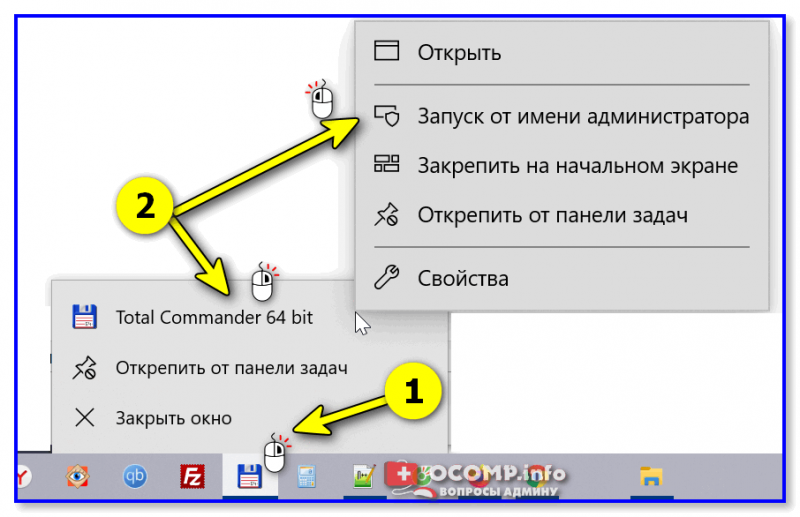
Запуск TC от имени админа
4) Затем необходимо открыть архив ZIP с плагином DiskInternals Reader в Total Commander — тогда он предложит вам установить плагин. Разумеется, соглашаетесь! 👌
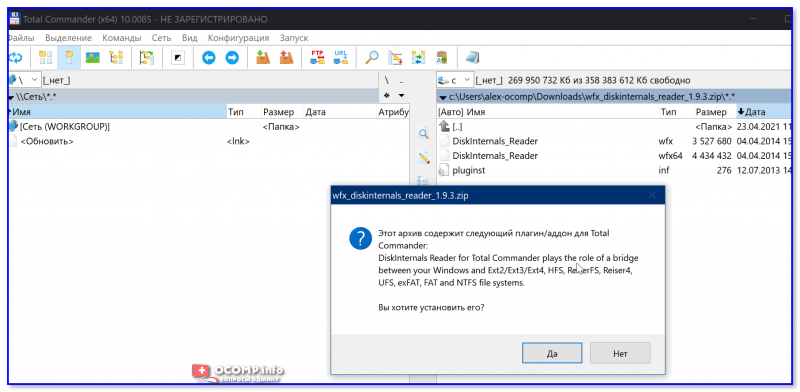
Установка плагина
5) Далее необходимо закрыть TC и снова его запустить от имени админа. В меню выбора диска укажите вариант «Сеть / FS-плагины» — далее кликните по значку DiskInternals Reader (см. стрелки 1, 2 на скрине ниже 👇).
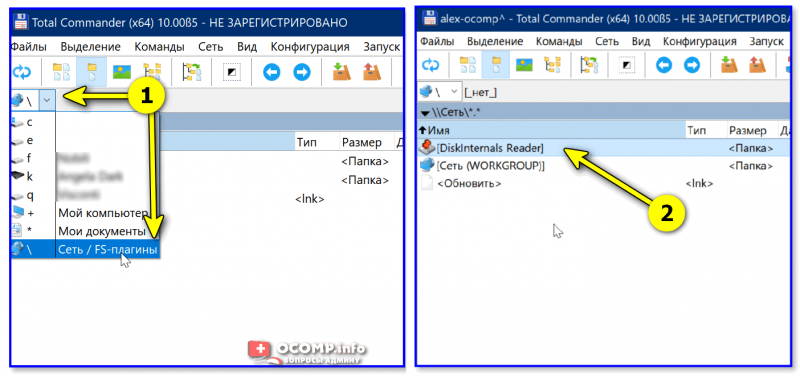
DiskInternals Reader
6) Собственно, далее появиться список всех дисков (в том числе и Ext2/3/4) — их можно открыть и скопировать с них нужную информацию. Задача решена?! 👌

Файлы читаются, можно копировать
*
Способ 3 (с помощью LiveCD)
Вообще, этот вариант, конечно, не относится к работе из-под Windows… Однако, он вполне себе годен для какой-то разовой работы (например, для копирования и переноса папки с файлами). К тому же аварийный LiveCD с Linux никогда не помешает — вдруг чего… 👌
1) Дистрибутивы Linux с поддержкой работы LiveCD — 👉 можете найти в моей подборке
2) Загруженный ISO-файл с нужной версией дистрибутива Linux необходимо правильно записать на флешку.
3) Далее останется только загрузиться с этой флешки с помощью Boot Menu (вызывается сразу после вкл. ПК). Если вы выберите дистрибутив Linux для новичка — то работать с ним весьма просто (ничуть не сложнее, чем с проводником Windows).
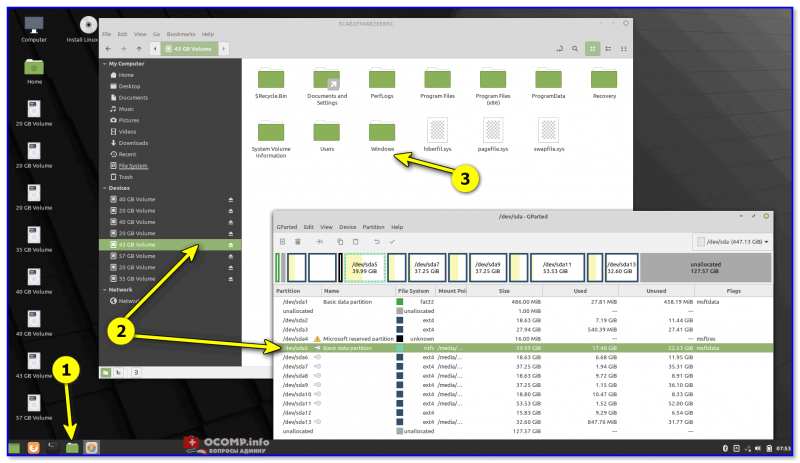
Linux Mint загружена с LiveCD
*
Дополнения приветствуются!
Успехов!
👌
In this article, we will be discussing five different ways to access Linux files from Windows. We’ll work on Ubuntu in this article, but you can use any distribution. Just identify the partition type that you’re using on your system and download the appropriate tool from this list.
Ubuntu supports Windows NTFS partitions but Windows can’t access Ubuntu partitions i.e. Ext4, Ext3, Ext2, etc. To access these partitions from windows when dual-booted with Ubuntu, this can only be done using third-party software. We will discuss some of the software to read and write Linux partitions.
Here are some free tools to access Linux files from windows without booting into Linux:
1. ext2fsd
ext2fsd can read Ext4, Ext3, Ext2 file systems and can even provide write access on enabling write support during the setup. You have to start it manually in Tools > Service Management and click on Start or you can set it to start automatically when the system boots. It is free and easy to install.
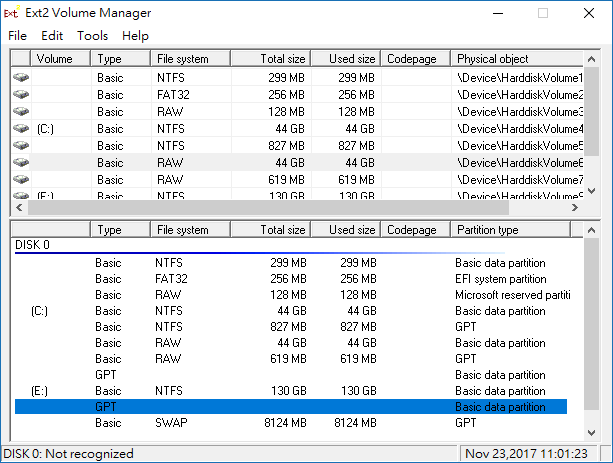
It assigns a drive letter to the Linux partitions or you can set it manually using Ext2 Volume Manager and can change ext2fsd’s settings. You can choose to assign the drive letter automatically in Tools > Service Management. Assigning a drive letter to Linux partitions allows apps to directly access Linux Files on Windows!
2. DiskInternals Linux Reader
Unlike ext2fsd, Linux Reader also supports ReiserFS, Reiser 4, HFS, HFS+(Apple’s file system), APFS, XFS, etc along with Ext4, Ext3, Ext2. It provides read-only access to keep the original files secure. It previews the contents of the files and bypasses the security policies of files which gives you access to any file on your Linux partition. It is free software for non-commercial use and works on Windows 7, 8, and 10.
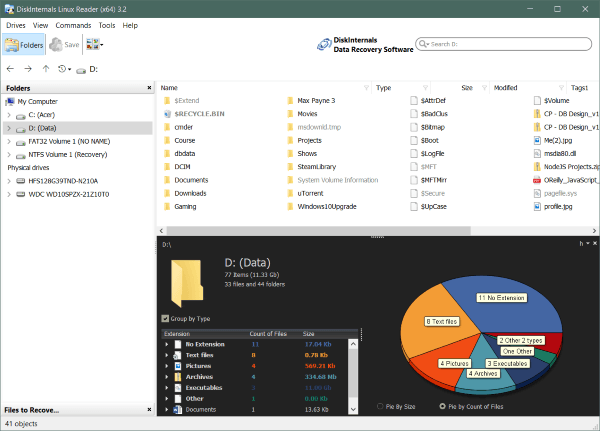
It also has a pro version i.e. Linux Reader Pro which provides some extra features such as remote access via SSH, Exporting files to an FTP server. You can download it through this link. Instead of assigning a drive letter, it shows the files in its application window. You can save the files to windows which you want to use.
3. Ext2Read
Ext2read is a free and open-source utility that works the same as the Linux Reader. It provides read-only access only to Ext4, Ext3, Ext2, and Ext4 Extents. It does not need to be installed, It is just a .exe file that should be run as an administrator. You can copy folders and even whole directories from Linux partitions. You can download the .exe file through this link.
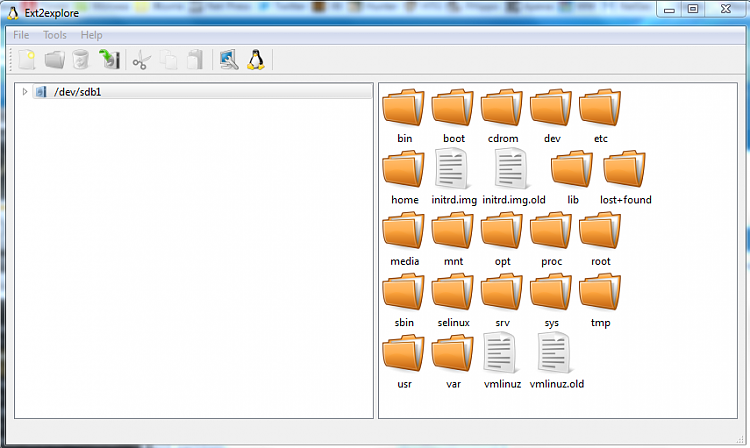
4. Explore2fs
Explore2fs is a tool that gives you access to Ext2 and Ext3 file systems. It supports all versions of windows, especially the older versions. This tool is used for the old hardware as it supports Floppy disks, CD-ROM, Jazz Disk and can export files as binary, text, or even directories. While not the best option, if you need to access Linux files on Windows on a old device, go for this one. You can download it from here.
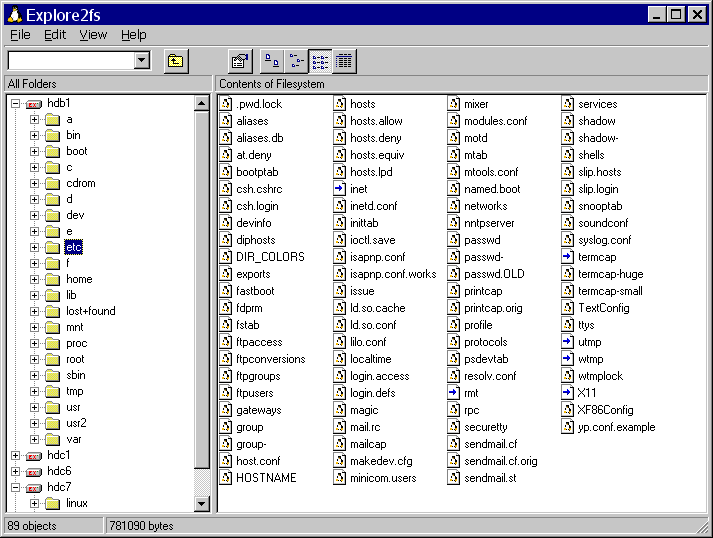
5. Ext2 IFS
Ext2 IFS is a tool used to access the Ext2 file system with read and write access. You can read, write, rename, move and delete files or directories. It works on Windows 7 and 8, Windows Server 2003, 2008, 2012, Windows XP, Windows Vista, and other old versions.
During installation, it will give the option to choose a drive letter for your Linux partition and after the installation, you will find the Linux file system in your file explorer.
Unlike other software discussed above, this tool can only access Ext2 file systems. You can download it through this link.
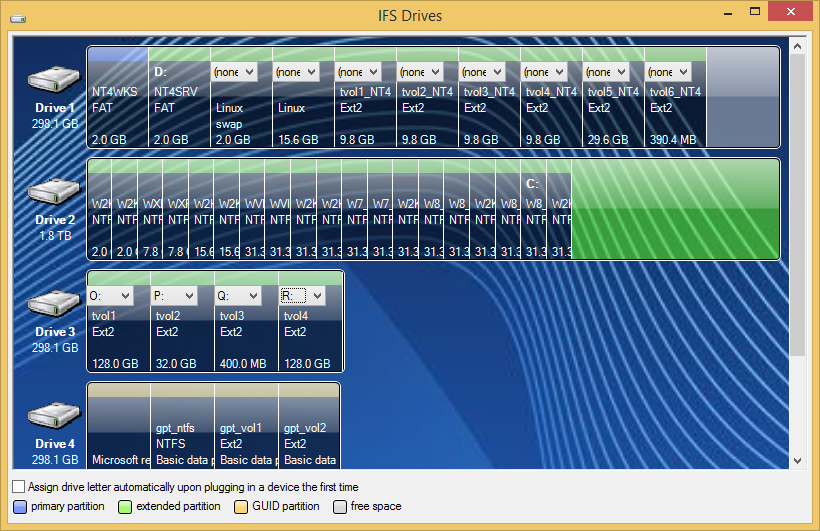
FAQs
What are some tools to access Linux files on Windows?
You can use tools like DiskInternals Linux Reader, Ext2Fsd, Explore2fs, WSL (Windows Subsystem for Linux), and Linux File Systems for Windows by Paragon to access Linux files on Windows.
How can I access Linux partitions from Windows?
You can use tools like Ext2Fsd or Linux File Systems for Windows by Paragon to access Linux partitions from Windows. These tools allow you to browse and save files from Linux partitions on your Windows system.
Can I access Ext4 partitions from Windows?
Yes, you can access Ext4 partitions from Windows using tools like Linux File Systems for Windows by Paragon which supports the Ext4 file system and allows you to access files from Ext4 partitions on your Windows PC.
Does Windows 10 have built-in support for accessing Linux files?
Windows 10 does not have built-in support for accessing Linux files. However, you can use third-party tools like DiskInternals Linux Reader or Linux File Systems for Windows by Paragon to access Linux files from Windows 10.
How can I transfer files between Windows and Linux systems?
You can transfer files between Windows and Linux systems by using tools like WSL (Windows Subsystem for Linux) or third-party applications like DiskInternals Linux Reader or Linux File Systems for Windows by Paragon.
Conclusion
So, We discussed different ways to access Ubuntu files from Windows without shutting windows and booting into Linux. Explore2fs and Ext2 IFS can be used for older versions of windows and can access old hardware as discussed.
If you dual-boot Windows and Ubuntu, or another Linux distribution, there may come a time when you need to get files from your Linux installation onto your Windows installation.
By default, it is impossible to read Linux partitions (filesystems) on Windows. Microsoft doesn’t provide the drivers to do this with the Windows kernel. However, there are ways to read these partitions. In this guide, we’ll show you how you can read Linux partitions on your Windows installation.
Before we begin
Mounting Linux partitions inside Windows can be dangerous, and it is possible to lose your data. Before attempting to mount your disks in Windows via WSL, or with Linux Reader, please ensure you have your important files backed up to the cloud, an external hard drive, etc.
If you just need to access files quickly, don’t necessarily require a lot of features, and don’t care that much about what you can do with Linux filesystems, Linux Reader is what you need.
Linux Reader is a third-party app that can scan your Windows PC for Linux-formatted hard drives and mount them. To get started with Linux Reader, head over to the official download page. Once you’re there, find the “Get it free” button, and select it with the mouse to download the EXE installer.
After downloading the EXE installer, launch Windows Explorer, select your “Downloads” folder, and double-click on “Linux_Reader.exe”. Once you’ve selected the EXE, launch it and install the program.
When you’ve installed Linux Reader on Windows, open up the Windows Start Menu, and launch “DiskInternals Linux Reader”. Once you launch it, you will need to approve it with User Account Control. Select “Yes.”
After giving Linux Reader admin access, it should show you both “volumes” and “physical drives.” “Volumes” stands for partition. Find the partition you wish to access in Windows in the “Volumes” section, and right-click on it.
Once you’ve right-clicked on the Linux drive in Linux Reader, find “Mount to Disk Letter,” and select it. Clicking this option will allow you to mount the disk to a Windows drive letter (like E, etc.)
Note: mounting it via a drive letter requires a pro license.
When the drive is mounted via a drive letter, you will be able to access your Linux data via Windows Explorer. To unmount it from a drive letter, find “Virtual Disk Manager” in Linux Reader, and select “Unmount.”
How to read Linux partitions in Windows via WSL
If you want a more robust way of accessing Linux filesystems on your Windows computer, you will need to use WSL (the Windows Subsystem for Linux). To start, you’ll need to open PowerShell (as Admin) and install WSL.
To install WSL in Windows PowerShell, enter the following command.
wsl --install
Upon entering the command above, you must reboot your Windows PC. After rebooting, log back in and you should have WSL installed. However, if not, access “Turn Windows features on or off,” and select “Windows Subsystem for Linux.”
After enabling WSL, change the version to 2, and enable the “Virtual Machine Platform” in PowerShell (in Admin mode).
wsl --set-default-version 2
dism.exe /online /enable-feature /featurename:VirtualMachinePlatform /all /norestart
You must now install a Linux distribution. This Linux distribution, once installed, will allow you to mount Linux partitions inside Windows.
wsl --install -d Ubuntu
After installing Ubuntu using the WSL command, launch it via the Windows start menu. Once Ubuntu is open, it will “finish installing”. When the installation is finished, use the following commands to update Ubuntu.
sudo apt update sudo apt upgrade -y
With Ubuntu up to date, use the Ubuntu terminal and create a new folder in the “mnt” directory, with the name “external-drives.” This folder is where you’ll mount your Linux partition.
sudo mkdir -p /mnt/external-drives/
After creating the folder, return to Windows PowerShell, and use the wmic diskdrive command to view available hard drives on your Windows PC.
wmic diskdrive list brief
Look through the list of drives for your Linux hard drive. Once you’ve found it, use the following command to mount it to WSL. Note, please change “PHYSICALDRIVEXX” to the drive label listed by the wmic command. Be sure to also change “–partition YY” to the correct partition number.
wsl --mount \\.\PHYSICALDRIVEXX --partition YY
Once the drive is mounted in WSL, return to the Ubuntu terminal and run the lsblk command. Look through the lsblk readout for your drive. You’ll know it’s your drive based on its size.
When you’ve located your drive, mount it to the /mnt/external-drives/ folder. Replace “sdXY” with your drive’s label. For example, your drive may be /dev/sdb1, or something similar.
sudo mount /dev/sdXY /mnt/external-drives/
After mounting the drive in the Ubuntu terminal, open up Windows Explorer, and find “Linux” in the sidebar. Click on it, and navigate to the “mnt” folder, followed by the “external-drives” folder. Once you’ve loaded up the “external-drives” folder in Windows Explorer, you’ll have access to your Linux files in Windows.

Position : Tips — How to Read and Write EXT4, EXT3 and EXT2 Drives in Windows 10/11?
This guide shows how to read and write data of Linux Ext2/Ext3/Ext4 partitions in Windows 11/10/8/7/Vista/XP. If you dual boot your computer with Windows and Linux, you’ll be able to access NTFS or FAT32 partitions under Linux, but you cannot access Linux partitions directly under Windows. If you need to read Ext4, Ext3 or Ext2 partitions under Windows 10/11 without booting into Linux, here is the tutorial that can help you.
Overview on reading Ext4/3/2 drives in Windows
«My computer is in a dual-boot environment with Windows 10 and Ubuntu. They are installed on one hard drive which is divided into two partitions C and D. Sometimes I want to grab files from Linux partition while computer has booted into Windows 10. It’s way too trouble to restart into Linux and copy files to a FAT32 partition and reboot back into Windows 10. Anyone here knows how to access Ext4 partitions from Windows 10?»
If your computer is dual-booting with Windows and Linux, you must have trouble in accessing files and folder stored in Linux partitions while Windows is running. The default file system type used on Windows and Linux are different, Windows users NTFS, exFAT, or FAT32, while Linux employs Ext2, Ext3, or Ext4 file systems. Besides, Linux has support for NTFS and FAT32 file system, which enables users to access files on Windows partitions. However, on the other hand Windows does not have inbuilt support for Linux partitions.
Therefore, you may come across such a situation that if you are using Windows and Linux together on a computer. You may need to use some files you downloaded in Linux, and you are logged into Windows OS already. Since you cannot access Linux partition directly, you’ll have to restart computer and boot to Linux, copy these files to a NTFS or FAT32 partition and then reboot computer to Windows. Wouldn’t it be better if you can access Linux partitions from Windows?
Nowadays, many users would like to dual boot Linux and Windows on one PC, and they often need to transfer data between two systems. Since Windows does not provide built-in tools to mount Linux partitions, we need to use third-party software to read & write data in Ext4/3/2 partitions. This article will introduce an effective tool to solve the problem. Keep reading the guide, you’ll be able to know how to mount and access files in Linux partitions under Windows 10/11.
Windows & Linux file systems
Some readers may wonder what a file system is. A file system is the tool for operating system to control, store, retrieve and organize files on a storage device. Why are there so many file system types? Different operating systems use and support specific types of file systems, for they target different users. For instance, Windows NT targets enterprise users and uses NTFS file system which enhanced security greatly; Windows 9X targets ordinary users and uses FAT file system which has less security but more performance.
As we all know that Windows and Linux uses different file systems: Windows uses NTFS, exFAT, and FAT32 file system, whereas Linux uses Ext2, Ext3 and Ext4. Thus, users cannot copy a file from Linux to Windows directly. It is quite complicated for an OS to add the support of a particular file system, especially adding support for proprietary file system. For example, the structure of data on disk, encryption algorithm and so on of NTFS file system are not known to the public, and it is very challenging to fully support NTFS in Linux.
Windows does not have native support for Linux file system like Ext2, Ext3 and Ext4. However, some tools have been created to solve this issue. Such software supports Linux file system and allows users to access Linux partitions under Windows. The follow section will introduce a Windows partition manager that can mount and access Linux partition from Windows.
Ext4/3/2 reader for Windows
If you have Windows and Linux on the same PC and want to access data of an EXT4 partition under Windows 10/11, then you need to use third-party software to read & write data in EXt4 partitions. Here we recommend DiskGenius Professional Edition to solve the problem. DiskGenius Professional Edition (formerly known as PartitionGuru) is advanced Windows partition manager and data recovery software. It can handle partitions formatted as NTFS, FAT32, FAT12, FAT16, exFAT, ReFS, Ext2, Ext3 and Ext4 file system from Windows.
Download DiskGenius
With this tool you can do following operations:
- Full access (write & read) to Ext2 / Ext3 / Ext4 partitions under Windows
- Create Ext2 / Ext3 / Ext4 partitions under Windows 11/10/8/7
- Format a drive to Ext4/3/2 in Windows 11/10/8/7
- Resize, shrink, extend, or split Ext2 / Ext3 / Ext4 partitions without deleting data
- Partition recovery — recover lost or deleted Ext4/3/2 partitions in Windows
- File recovery – recover deleted or lost files from Ext4/3/2 partitions in Windows
- Clone or back up Ext2 / Ext3 / Ext4 partitions
- Edit hex data of Ext2 / Ext3 / Ext4 partitions
- Check and repair disk bad sectors
Guide 1. How to mount Ext4/Ext3/Ext2 partitions in Windows 10/11?
Mounting Ext4 partitions in Windows is the first step before we can read or write data in the volume. Now we can use DiskGenius to open the Ext4 partition.
Step 1. Connect the disk that contains Ext4 partitions to your computer and boot your PC into Windows 10.
Step 2. Download and install DiskGenius Professional Edition on your PC and then launch it.
Step 3. Once DiskGenius is launched, you can view all disks and partitions attached to this computer. Select the Ext4 partition and you can browse files and folders in it.
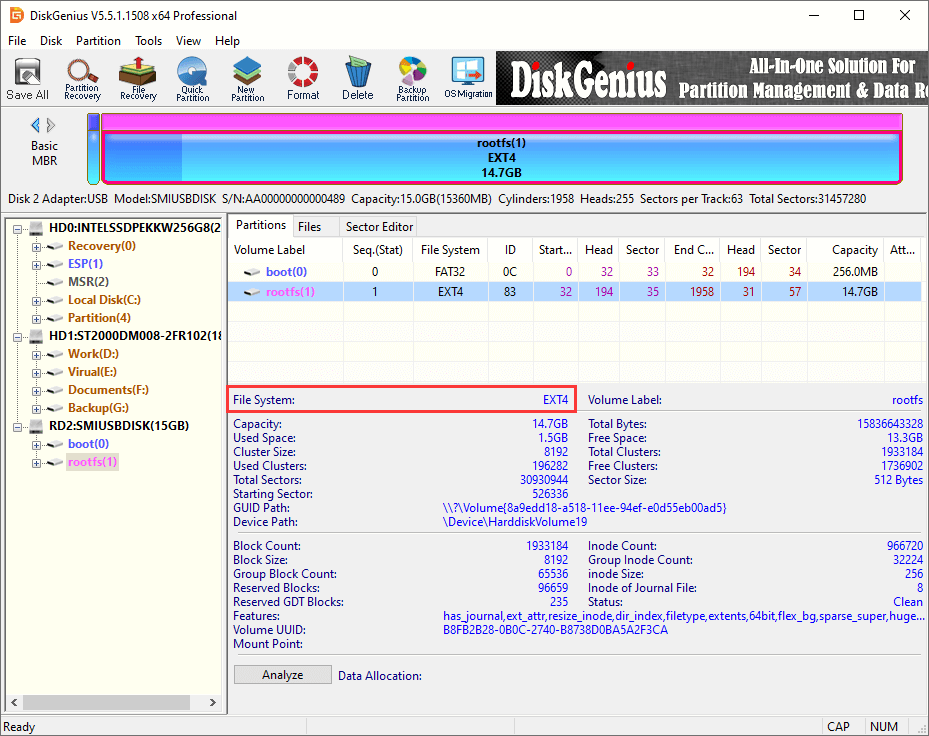
Step 4. Select the Ext4 partition and click Files tab, and you can see data in the root directory. Then you can double click a folder to open it and view files in it.
Guide 2. How to read files of Ext4 partitions in Windows 10/11?
Once the Ext4 partition is recognized by DiskGenius, you can read & write files in the partition.
File paths and directories are listed in the left pane like Windows File Explorer, and you can click path and view files on the right pane. Click a file on the right pane, and you can see the thumbnail preview, as follows.
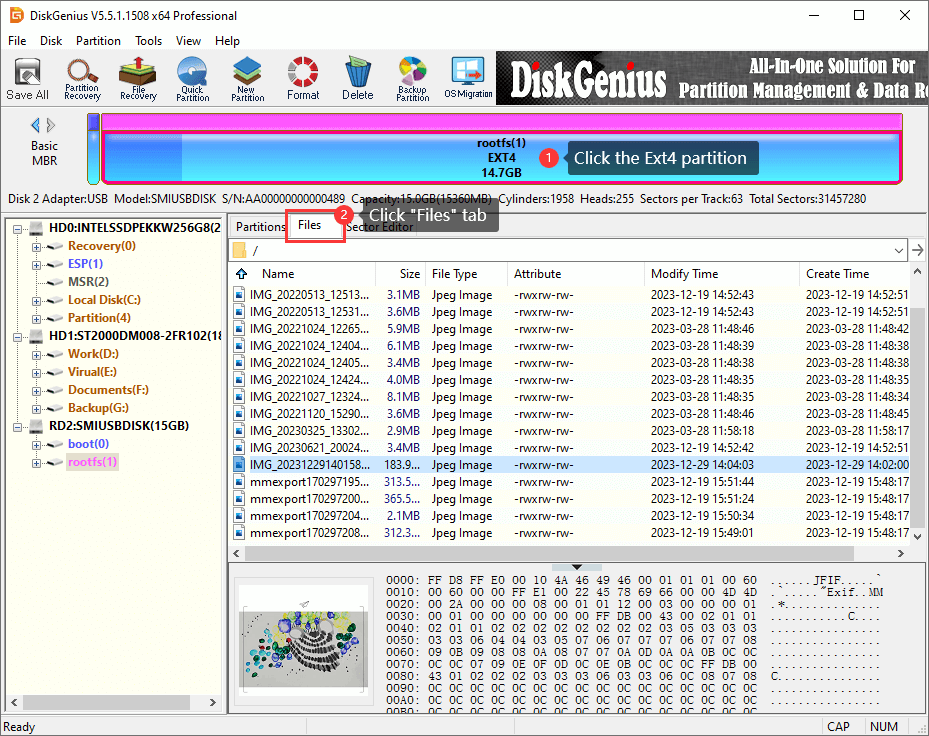
You can double-click the file to open it and view file content in its original size. This tool supports to preview photos, audio, video, Microsoft Office documents, PDF files, and text files.
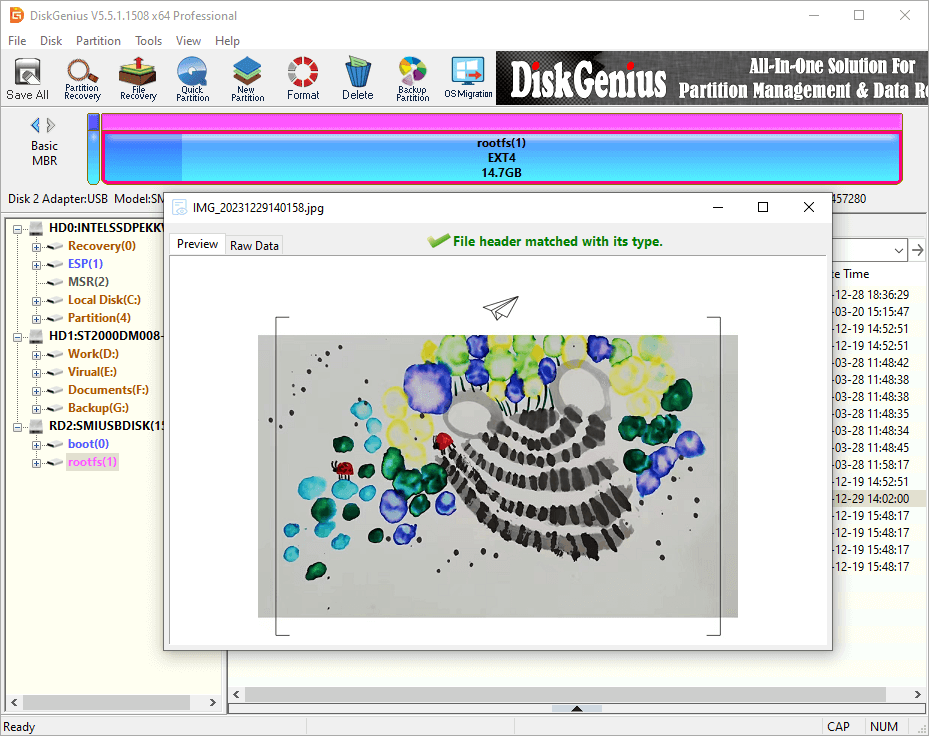
Guide 3. How to write data into Ext4 partitions in Windows 10/11?
With DiskGenius Professional Edition, you can create new folders in the Ext4 partition, write files to this Ext4 partition, rename files and folder, delete files, export files of the Ext4 partition to another drive, etc. Here are some examples:
Example 1: Write files to Ext4 partitions
Step 1. Open the folder where you want to add data and right-click empty space on the right pane to choose «Copy Files To Current Partition«.
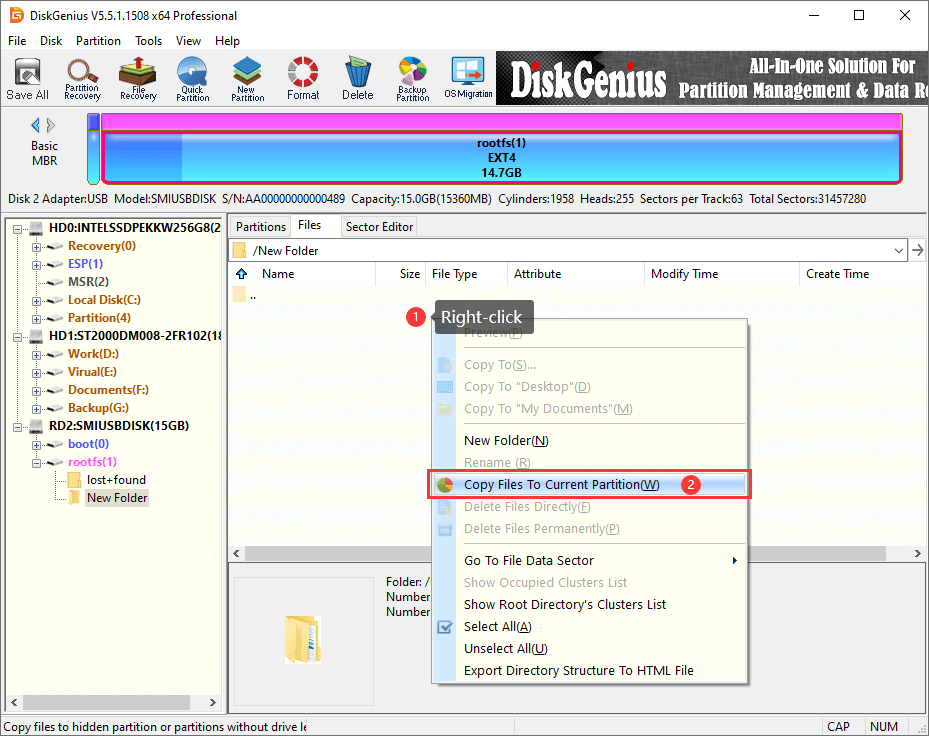
Step 2. Select files from other partitions or hard drives on your computer and Open. Wait for a while, and files will be write into this Ext4 partition.
Tip: This software also allows users to export files from the Ext4 partition to another partition on this computer: Select files you want to output -> right-click files and select «Copy To» -> select target location — > begin outputting files.
Example 2: Permanently delete files from Ext4 partitions
This feature is able to delete files permanently so that they cannot be recovered by any means, as the software overwrites the disk space while deleting files. If you just want to delete files, you can use Delete Files Directly
Step 1. Select and right-click files you want to delete and select «Delete Files Permanently» option from context menu.
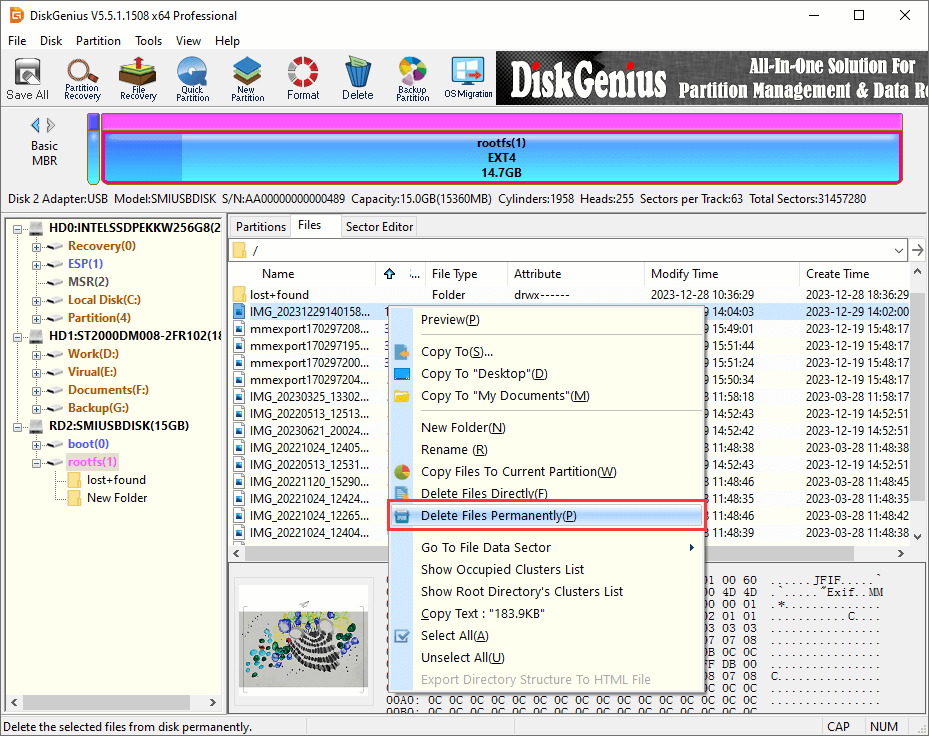
Step 2. Click «Permanently Delete» button on the popup window. Then the selected file will be deleted permanently.
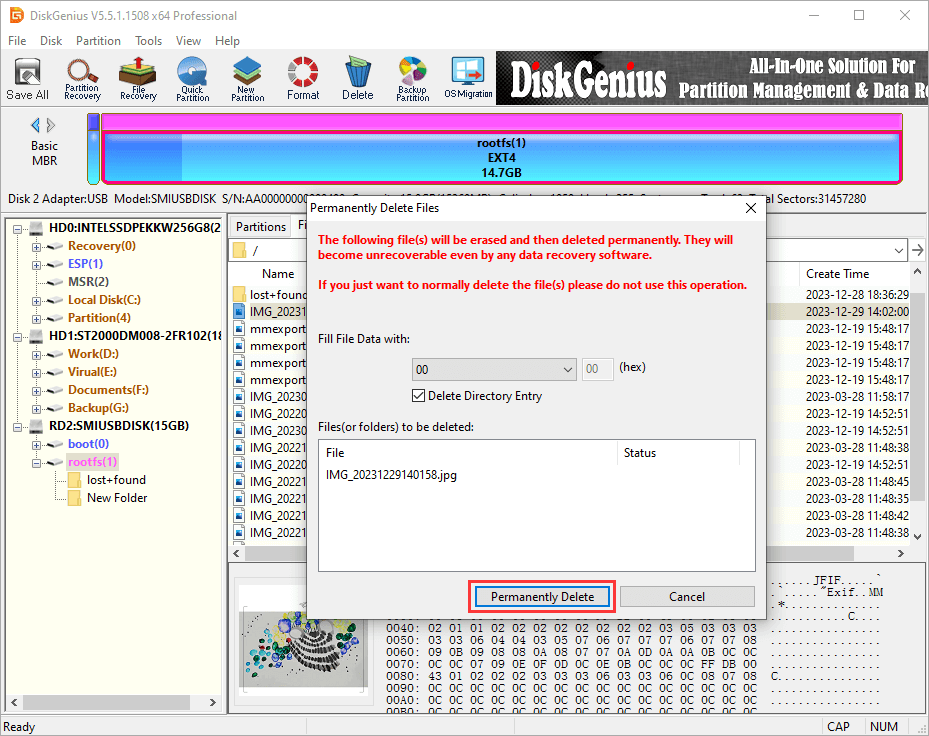
Example 3: Rename files or folders in Ext4 partitions
In addition to creating new folders, you can also rename files or folders in the software as follows:
Step 1. Right-click on a file or folder you want to change name and select «Rename«.
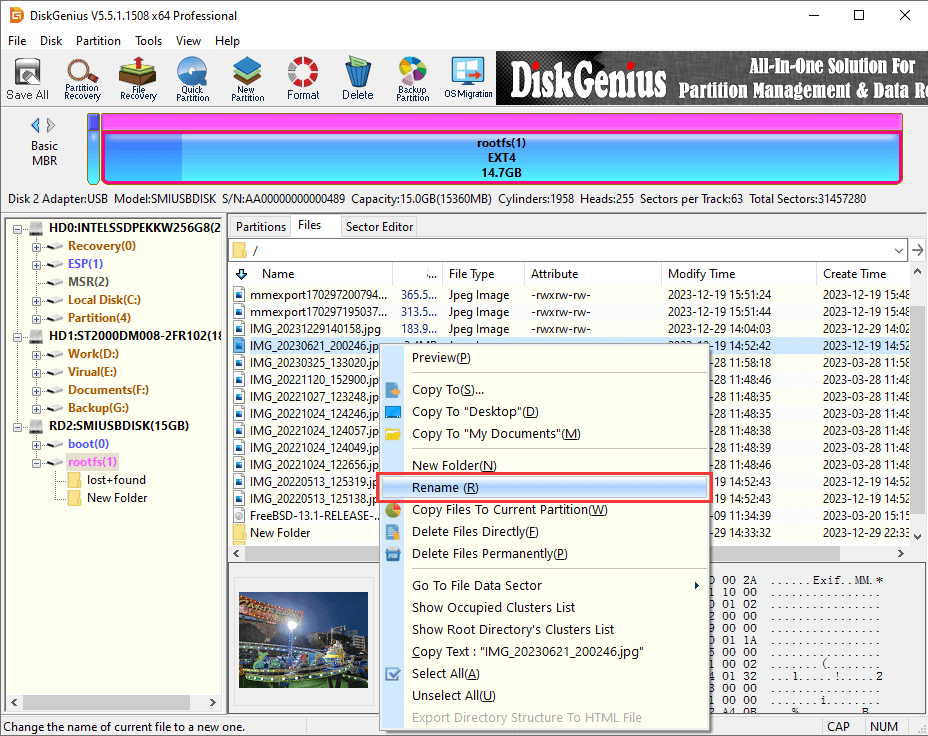
Step 2. Put in the desired name and click «OK» button.
Guide 4. How to resize Ext4 partitions without losing data in Windows 10/11?
The feature of resizing Ext4 partition without losing data is available for the DiskGenius Free Edition, and you can free download the free edition to resize, extend, or split an Ext4, Ext3 or Ext2 partition without deleting existing data in Windows 11/10/8/7.
Step 1. After launch DiskGenius, you can easily locate the Ext4 partition. Right-click it and choose «Resize Partition».
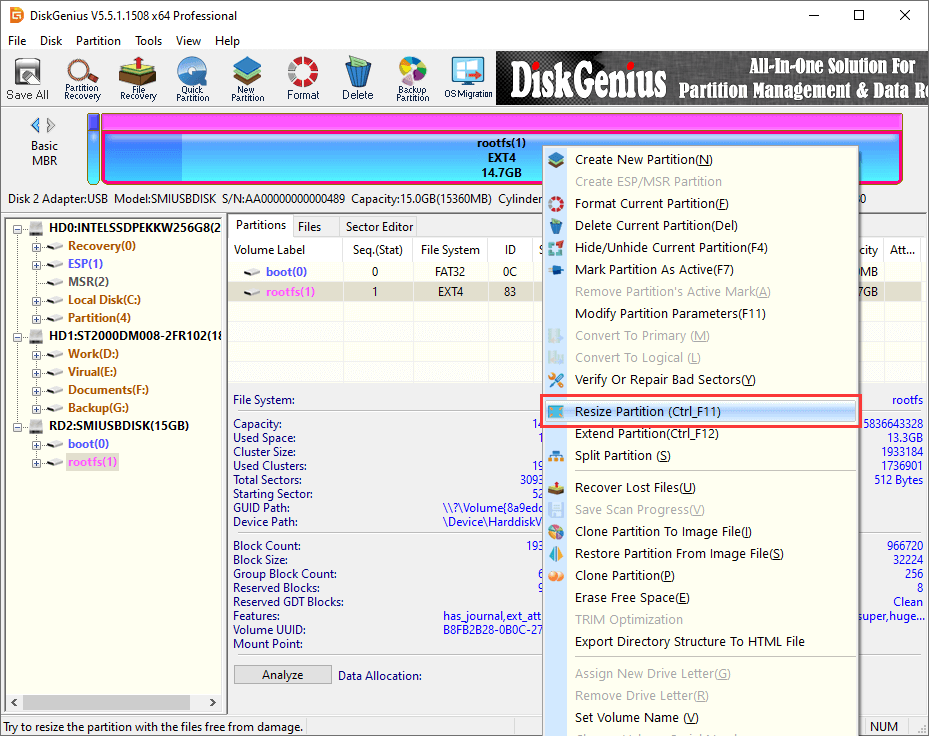
Step 2. Adjust partition size based on your needs. You can change partition size either by manually inputting the size or by dragging the partition boundaries.
The free disk space gained from the partition can be left as unallocated or created as a new partition.
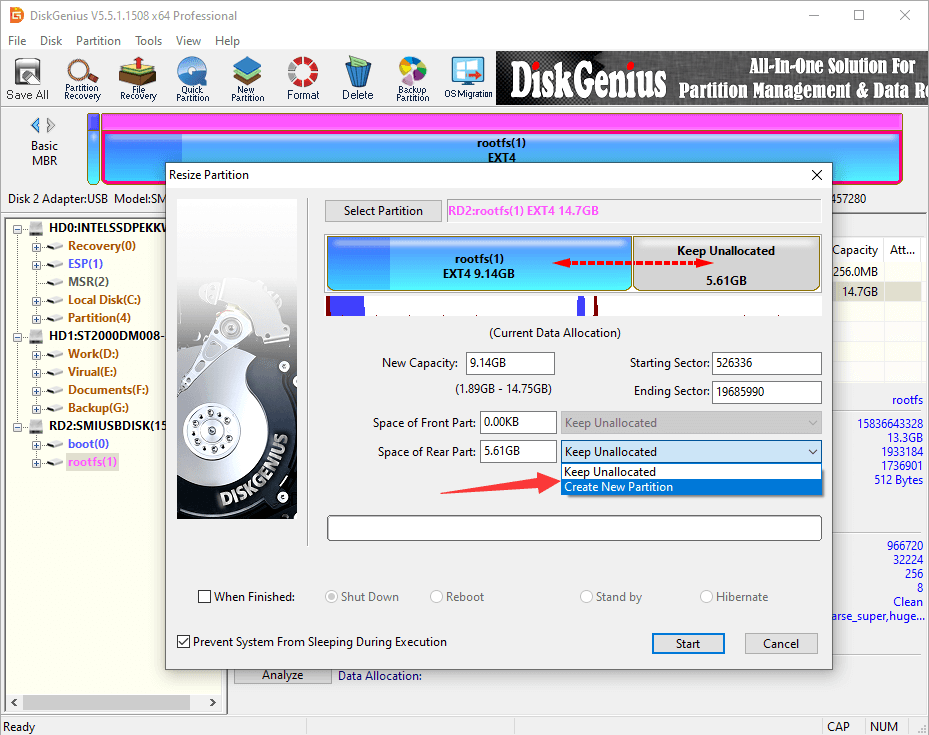
Step 3. Carefully read the notes. Click «Yes» to confirm and continue.
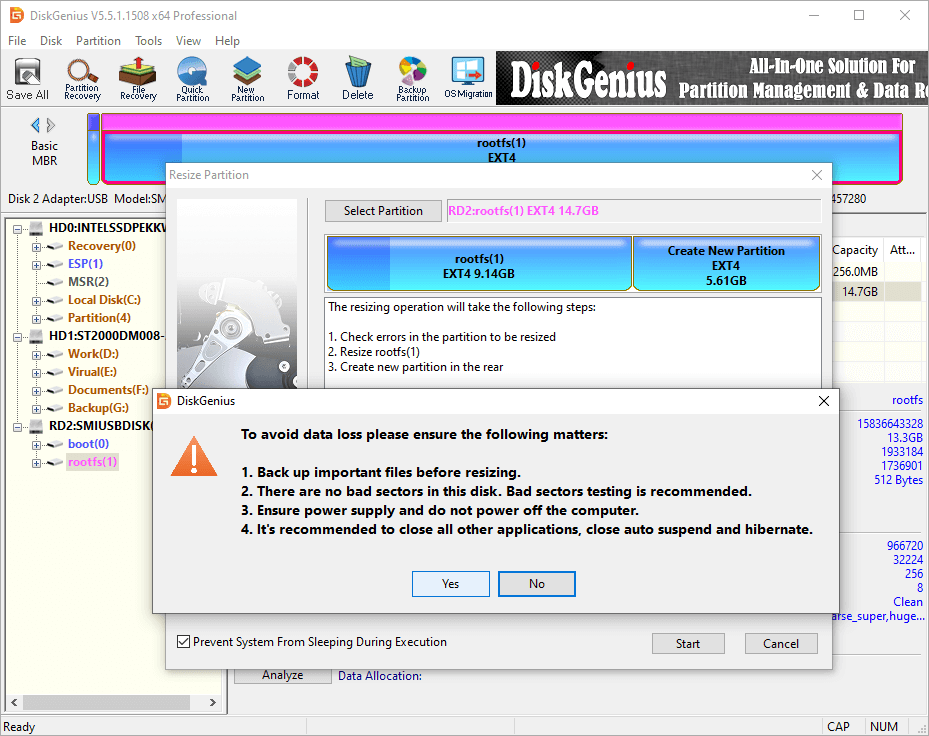
Step 4. DiskGenius is resizng the partition. The process might take some time depending on the size of the partition and the amount of data stored on it. Please be patient.
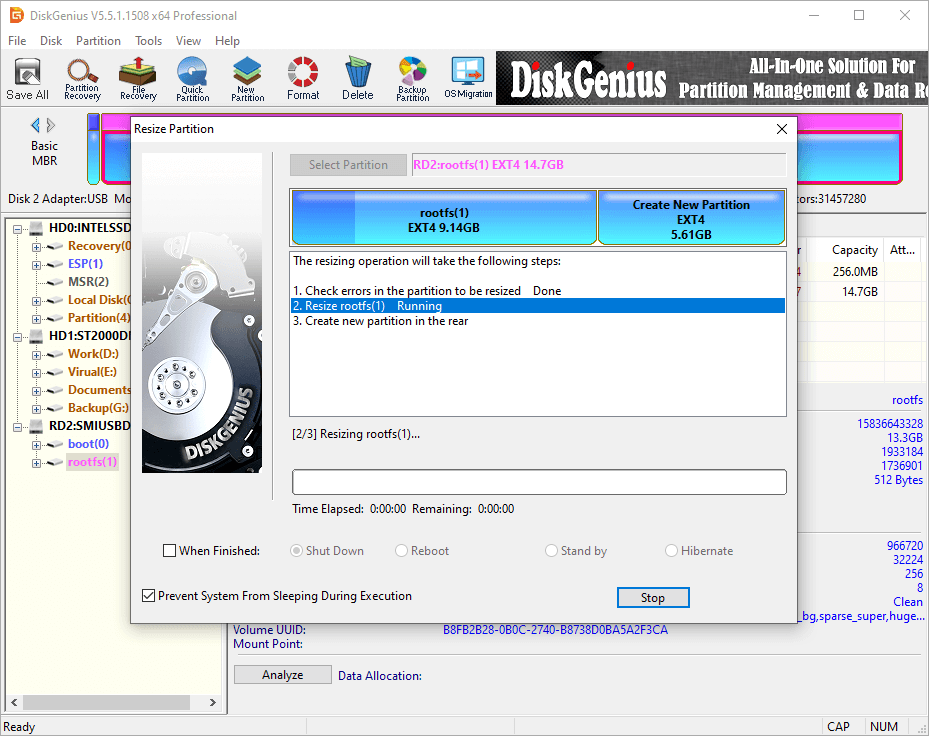
Guide 5. How to format a drive to Ext4/3/2 in Windows 10/11?
DiskGenius Free Edition support creating or formatting Linux-specific file systems like ext4, ext3, or ext2 within Window. The following steps shows how to format a partition to Ext4 using DiskGenius Free Edition in Windows 10.
Step 1. After launching DiskGenius Free Edition, you can select the partition to be formatted, click «Format» button. Then you can choose Ext4 as the file system and click «Format» button.
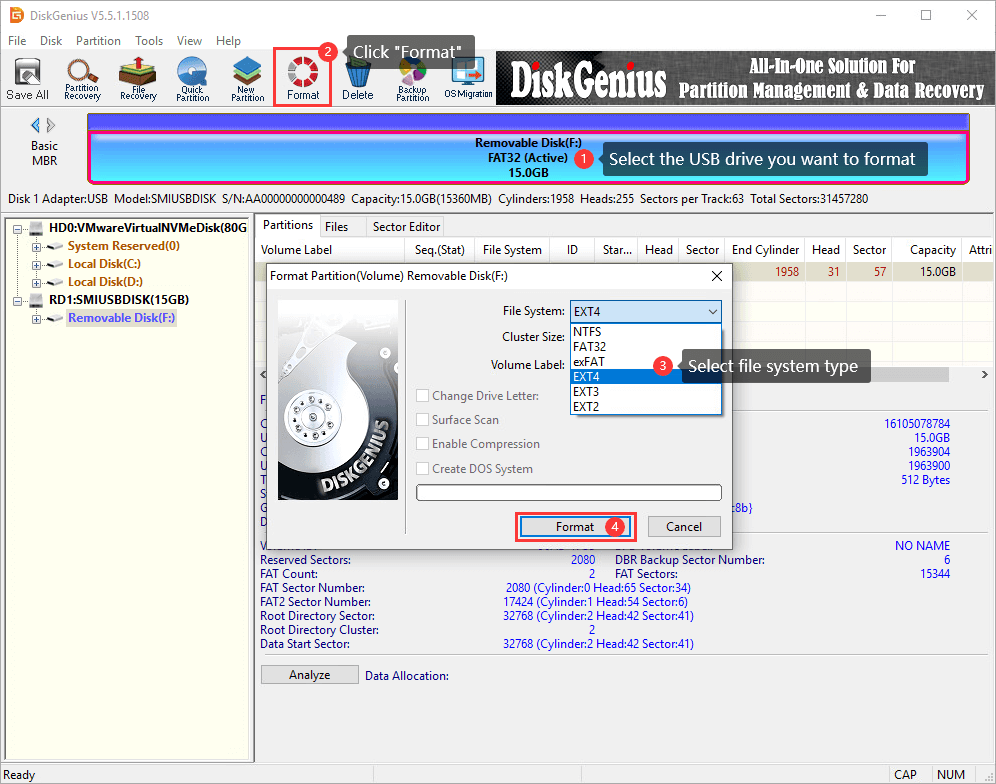
Step 2. A warning message pops up, saying all data on the drive will be erased by the formatting. If you don’t have any important data on the drive, click «Yes» to continue. Then DiskGenius starts to format the drive.
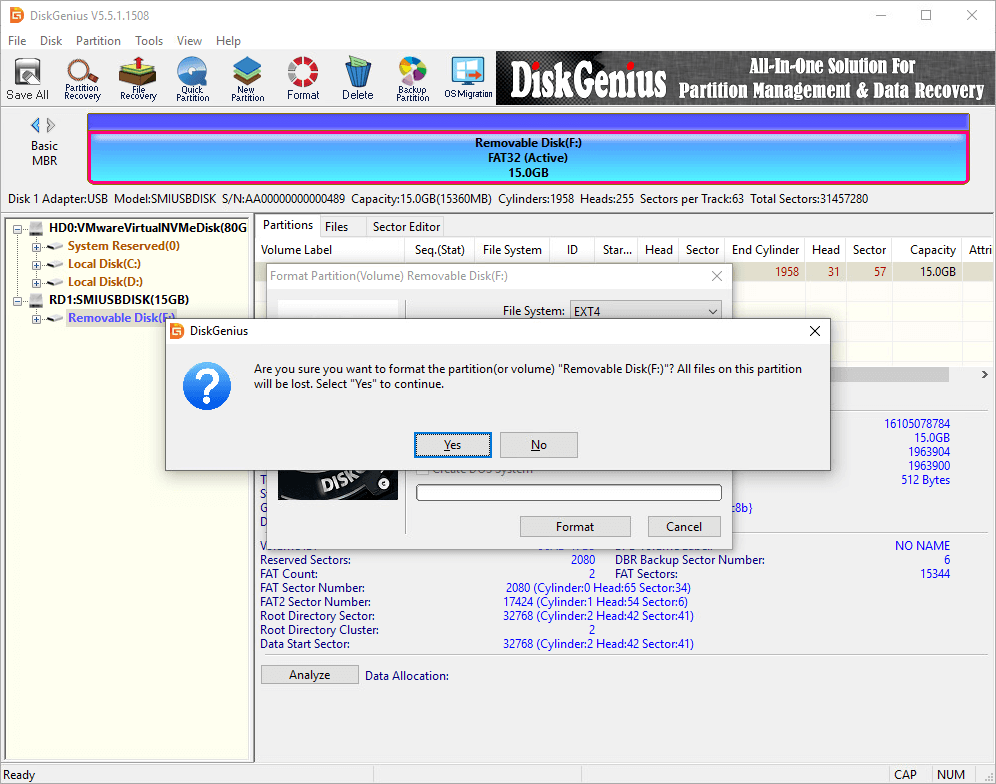
The drive is formatted as Ext4 successfully.
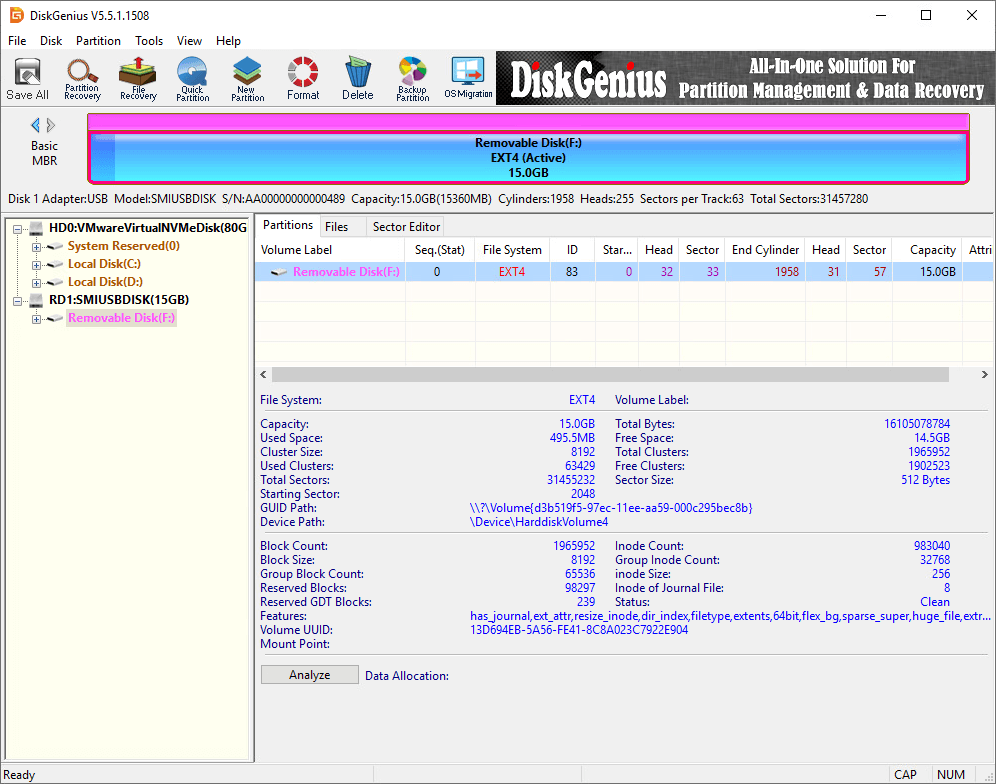
Here’s the video guide on how to format a partition to Ext4 file system in Windows 10:
Conclusion
DiskGenius is a handy and versatile Linux reader for Windows users. By using the software, you can easily read or write your Ext4, Ext3, and Ext2 partitions from Windows 11/10/8/7. Moreover, it also supports to manage Ext4/3/2 partitions to help you get the best use of disk space. If you are one of the dual-boot users, DiskGenius Professional Edition will be your best assistance.







